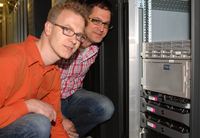© Universität Bielefeld
uni.news
Published on
28. Juni 2013
Category
General
Bielefeld University to host the European node for human genome data
US-American genome server is being twinned in Ostwestfalen
Since 2001, the human genome has been accessible on the Internet over the ‘UCSC Genome Browser’. It is hosted by University of California, Santa Cruz, USA. This Website is used intensively by geneticists, molecular biologists, and medical scientists engaged in research on the human genome throughout the world. However, the strong demand is straining the data link across the Atlantic. The answer has been to set up a computer in Europe to feed a copy of the Genome Browser into the Internet. The contract went to Bielefeld University. Technicians from the University of California linked up the server. Since 26th of June Bielefeld University hosts the European node of the genome server.
 ‘We are delighted to be able to take on this task’, says Professor Dr. Jens Stoye from Bielefeld University’s Center for Biotechnology (CeBiTec). ‘That was a great feeling when the University of California said that Bielefeld’s Bioinformatics was the best location for the server, Stoye reports. The ‘UCSC Genome Browser’ is in the public domain, and its data come from the non-commercial Human Genome Project. Bielefeld University’s Institute for Bioinformatics at CeBiTec, Faculty of Technology, and University Computing Centre (HRZ) are financing the running costs of the new server; the University of California is paying for its acquisition, installation, and servicing.
‘We are delighted to be able to take on this task’, says Professor Dr. Jens Stoye from Bielefeld University’s Center for Biotechnology (CeBiTec). ‘That was a great feeling when the University of California said that Bielefeld’s Bioinformatics was the best location for the server, Stoye reports. The ‘UCSC Genome Browser’ is in the public domain, and its data come from the non-commercial Human Genome Project. Bielefeld University’s Institute for Bioinformatics at CeBiTec, Faculty of Technology, and University Computing Centre (HRZ) are financing the running costs of the new server; the University of California is paying for its acquisition, installation, and servicing.
The international scientific community draws on this digital genetic database to gain information on the construction and function of individual genes. The browser presents the human genome graphically: users can explore the chromosomes, that is, the genetic information carriers, on-screen; they can zoom in and out; and they can read the reports of researchers from throughout the world. They can upload their own gene sequences and compare these with the genome data. This free database is also used in study courses for the natural sciences and medicine.
You can access the browser over the Internet address genome.ucsc.edu. Alongside the human genome, you can currently study the genetic make-up of 45 other species. This includes the reconstruction of the genome of Neanderthal man who died out 45,000 years ago. You can also inspect the genome of chimpanzees, orang-utans, cows, puffer fish, and mosquitos on the Website.
The Institute for Bioinformatics at the Center for Biotechnology (CeBiTec) is part of Bielefeld University's ‘Molecular and Nano Sciences’ profile. In this broad field, the University has built up a strong national and international position through its focus on the interfaces between physics, chemistry, biology, and bioinformatics. Current research ranges from nanolayers and single molecule processes up to bacterial, vegetable, and animal cells.
For more information in the Internet, go to:
genome.ucsc.edu
Contact:
Prof. Dr. Jens Stoye, Bielefeld University
Faculty of Technology, Genome Informatics
Telephone: 0521 106-3852
Email: jens.stoye@uni-bielefeld.de
Since 2001, the human genome has been accessible on the Internet over the ‘UCSC Genome Browser’. It is hosted by University of California, Santa Cruz, USA. This Website is used intensively by geneticists, molecular biologists, and medical scientists engaged in research on the human genome throughout the world. However, the strong demand is straining the data link across the Atlantic. The answer has been to set up a computer in Europe to feed a copy of the Genome Browser into the Internet. The contract went to Bielefeld University. Technicians from the University of California linked up the server. Since 26th of June Bielefeld University hosts the European node of the genome server.
Professor Dr. Jens Stoye (left) and Dr. Alexander Goesmann from the Center for Biotechnology (CeBiTec) have now launched the server carrying data on the human genome.
The international scientific community draws on this digital genetic database to gain information on the construction and function of individual genes. The browser presents the human genome graphically: users can explore the chromosomes, that is, the genetic information carriers, on-screen; they can zoom in and out; and they can read the reports of researchers from throughout the world. They can upload their own gene sequences and compare these with the genome data. This free database is also used in study courses for the natural sciences and medicine.
You can access the browser over the Internet address genome.ucsc.edu. Alongside the human genome, you can currently study the genetic make-up of 45 other species. This includes the reconstruction of the genome of Neanderthal man who died out 45,000 years ago. You can also inspect the genome of chimpanzees, orang-utans, cows, puffer fish, and mosquitos on the Website.
The Institute for Bioinformatics at the Center for Biotechnology (CeBiTec) is part of Bielefeld University's ‘Molecular and Nano Sciences’ profile. In this broad field, the University has built up a strong national and international position through its focus on the interfaces between physics, chemistry, biology, and bioinformatics. Current research ranges from nanolayers and single molecule processes up to bacterial, vegetable, and animal cells.
For more information in the Internet, go to:
genome.ucsc.edu
Contact:
Prof. Dr. Jens Stoye, Bielefeld University
Faculty of Technology, Genome Informatics
Telephone: 0521 106-3852
Email: jens.stoye@uni-bielefeld.de